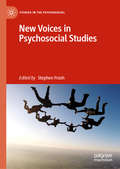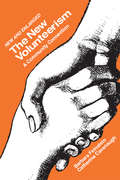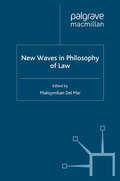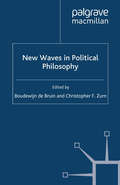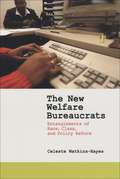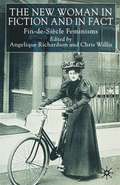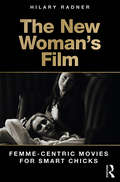- Table View
- List View
New Vocabularies in Film Semiotics
by Robert Stam Robert Burgoyne Sandy Flitterman-LewisFirst published in 1992. Routledge is an imprint of Taylor & Francis, an informa company.
New Voices in Psychosocial Studies (Studies in the Psychosocial)
by Stephen FroshPsychosocial studies in the UK is a diverse area of work characterised by innovation in theory and empirical research. Its extraordinary liveliness is demonstrated in this book, which showcases research undertaken at the Department of Psychosocial Studies at Birkbeck, University of London, UK, highlighting three domains central to the discipline – psychoanalysis, ethics and reflexivity, and resistance. The book engages psychosocially with a wide variety of topics, from social critiques of psychoanalysis through postcolonial and queer theory to studies of mental health and resistance to discrimination. These ‘New Voices in Psychosocial Studies’ offer a coherent yet wide-ranging account of research that has taken place in one ‘dialect’ of the new terrain of psychosocial studies and an agenda-setting manifesto for some of the kinds of work that might ensure the continued creativity of psychosocial studies into the next generation. This book demonstrates the ongoing development of psychosocial studies as an innovative, critical force and will inspire both new and established researchers from across the fields that influence its transdisciplinary approach, including: critical psychology and radical sociology, feminist, queer and postcolonial theory, critical anthropology and ethnography and phenomenology.
The New Volunteerism: A Community Connection
by Catherine CavanaughThis unique volume is a case study of a successful and innovative program using case aide volunteers to deinstitutionalize mental patients. It will serve as an important reference for professionals, teachers, and administrators who are involved in the "business" of human services and require concrete information on how to develop effective volunteer programs to bridge the widening gap between services and needs. The authors use their particular program as an empirical blueprint for principles undergirding the successful use of volunteers as extensions of professional social service staff. The case-aide handbook appended to the volume provides a "quick prescription" formula for how this volunteer program was made viable and how these techniques can be adapted to other programs. In the new and enlarged edition of The New Volunteerism, the authors tell about "whatever happened to..." the case aides in their program, based on the responses to a questionnaire they designed and mailed to 100 of these men and women. Models for Volunteer/Professional Partnerships are defined and illustrated with creative and innovative volunteer programs reviewed by Feinstein and Cavanaugh. These programs serve many different populations, including: alcoholics, the elderly, the mentally ill, the retarded, abusive parents, and the terminally ill.
The New Volunteerism: A Community Connection
by Catherine CavanaughThis unique volume is a case study of a successful and innovative program using case aide volunteers to deinstitutionalize mental patients. It will serve as an important reference for professionals, teachers, and administrators who are involved in the "business" of human services and require concrete information on how to develop effective volunteer programs to bridge the widening gap between services and needs. The authors use their particular program as an empirical blueprint for principles undergirding the successful use of volunteers as extensions of professional social service staff. The case-aide handbook appended to the volume provides a "quick prescription" formula for how this volunteer program was made viable and how these techniques can be adapted to other programs. In the new and enlarged edition of The New Volunteerism, the authors tell about "whatever happened to..." the case aides in their program, based on the responses to a questionnaire they designed and mailed to 100 of these men and women. Models for Volunteer/Professional Partnerships are defined and illustrated with creative and innovative volunteer programs reviewed by Feinstein and Cavanaugh. These programs serve many different populations, including: alcoholics, the elderly, the mentally ill, the retarded, abusive parents, and the terminally ill.
The New War Plays: From Kane to Harris
by J. BollHow can war be represented on stage? How does the theatre examine the structures leading to violence and war and explore their transformation of societies? Springing from the discussion about 'New Wars' in the age of globalisation, this interdisciplinary study demonstrates how these 'New Wars' bring forth new plays about war.
New Wars and Old Plagues: Armed Conflict, Environmental Change and Resurgent Malaria in the Southern Caucasus
by Katherine Hirschfeld Kirsten de Beurs Brad Brayfield Ani Melkonyan-GottschalkThis Open Access book uses Mary Kaldor’s concept of “New Wars” to explore how ethnic conflict reshaped the social and environmental landscape of the Southern Caucuses following the collapse of the Soviet Union. It relies on remote sensing data and qualitative historical research to explore how armed conflict between non-state actors generated the region’s largest epidemic of P. vivax malaria since the 1960s. This book is an important addition to the literature on the Karabakh conflict and conflict studies more broadly because the infectious disease outbreaks associated with warfare often kill more people than the armed conflicts themselves. Warfare itself has also changed dramatically since the collapse of the USSR, and the Karabakh conflict provides an excellent case study of the way “New Wars” transform the natural and social environment to facilitate outbreaks of preventable disease. This extended case study will be useful to researchers from a variety of academic disciplines, including medical anthropology, geography, conflict studies, disease ecology, global health and public health. It also reveals the fragility of twentieth century malaria control in temperate regions and will assist in predictive modeling for future outbreaks.
New Wave: Image is Everything (Pop Music, Culture and Identity)
by K. AdkinsNew Wave: Image is Everything traces the evolution of the often neglected pop music genre, new wave. Using artists from Elvis Costello to Cyndi Lauper as illustrations, the book argues that new wave was among the first flowerings of postmodern theory in popular culture.
New Waves in Global Justice (New Waves in Philosophy)
by Thom BrooksWith essays ranging from climate change and global poverty to just war and human rights and immigration, leading future figures present an ideal collection for anyone interested in the most important debates in global justice.
New Waves in Philosophy of Law (New Waves in Philosophy)
by Maksymilian Del MarA collection of 11 cutting-edge essays by leading young scholars, challenging long-held assumptions and offering new research paradigms in Philosophy of Law - in five parts 1) methodology/metatheory; 2) reasoning/evaluating; 3) values/the moral life; 4) institutions/the social life; and 5) the global/international dimension.
New Waves in Philosophy of Technology (New Waves in Philosophy)
by Jan Kyrre Berg OlsenThe volume advances research in the philosophy of technology by introducing contributors who have an acute sense of how to get beyond or reframe the epistemic, ontological and normative limitations that currently limit the fields of philosophy of technology and science and technology studies.
New Waves In Political Philosophy (New Waves in Philosophy)
by Boudewijn De Bruin C. ZurnComprising essays by eleven up-and-coming scholars from across the globe, this collection of essays provides an unparalleled snapshot of new work in political philosophy using such diverse methodologies as critical theory and social choice theory, historical analysis and conceptual analysis.
New Ways of Communicating Archaeology in a Digital World (Interdisciplinary Contributions to Archaeology)
by Sofia Fonseca Ben Thomas Aurélia BasterracheaThis book examines the communication and interaction between archaeologists and the non-archaeological public in a digital age. Moving beyond traditional methods, the book focuses on communication through new (YouTube, MOOCs, TEDx, etc.) and alternative media (virtual and augmented reality, video games, comics, etc.) that connect a traditional archaeological world to a modern digital one. By featuring case studies that make this point, the volume argues for the need to integrate new technologies and media like online education, storytelling, podcasting, and augmented and virtual reality into archaeologists’ efforts to communicate their work to the broader society. Drawn from a session at the European Association of Archaeologists Annual Conference in 2018, the book was expanded and enhanced by the inclusion of presentations from the 2020 conference and additional invited papers. The volume presents a variety of approaches to archaeological education that highlight the need for creativity and resourcefulness in re-thinking archaeological presentations in a digital and virtual environment. This volume is of interest to archaeologists, as well as researchers and practitioners in museology and heritage and serves as a guide for archaeologists interested and involved in the world of non-academic communication. This book invites the reader to be part of a movement that is redefining the dialogue between our past and the future of communication, learning, and digital storytelling.
The New Welfare Bureaucrats: Entanglements of Race, Class, and Policy Reform
by Celeste Watkins-HayesAs the recession worsens, more and more Americans must turn to welfare to make ends meet. Once inside the agency, the newly jobless will face a bureaucracy that has undergone massive change since the advent of welfare reform in 1996. A behind-the-scenes look at bureaucracy’s human face, The New Welfare Bureaucrats is a compelling study of welfare officers and how they navigate the increasingly tangled political and emotional terrain of their jobs. Celeste Watkins-Hayes here reveals how welfare reform engendered a shift in focus for caseworkers from simply providing monetary aid to the much more complex process of helping recipients find work. Now both more intimately involved in their clients’ lives and wielding greater power over their well-being, welfare officers’ racial, class, and professional identities have become increasingly important factors in their work. Based on the author’s extensive fieldwork in two very different communities in the northeast, The New Welfare Bureaucrats is a boon to anyone looking to understand the impact of the institutional and policy changes wrought by welfare reform as well as the subtle social dynamics that shape the way welfare is meted out at the individual level.
The New Welfare Bureaucrats: Entanglements of Race, Class, and Policy Reform
by Celeste Watkins-HayesAs the recession worsens, more and more Americans must turn to welfare to make ends meet. Once inside the agency, the newly jobless will face a bureaucracy that has undergone massive change since the advent of welfare reform in 1996. A behind-the-scenes look at bureaucracy’s human face, The New Welfare Bureaucrats is a compelling study of welfare officers and how they navigate the increasingly tangled political and emotional terrain of their jobs. Celeste Watkins-Hayes here reveals how welfare reform engendered a shift in focus for caseworkers from simply providing monetary aid to the much more complex process of helping recipients find work. Now both more intimately involved in their clients’ lives and wielding greater power over their well-being, welfare officers’ racial, class, and professional identities have become increasingly important factors in their work. Based on the author’s extensive fieldwork in two very different communities in the northeast, The New Welfare Bureaucrats is a boon to anyone looking to understand the impact of the institutional and policy changes wrought by welfare reform as well as the subtle social dynamics that shape the way welfare is meted out at the individual level.
The New Welfare Bureaucrats: Entanglements of Race, Class, and Policy Reform
by Celeste Watkins-HayesAs the recession worsens, more and more Americans must turn to welfare to make ends meet. Once inside the agency, the newly jobless will face a bureaucracy that has undergone massive change since the advent of welfare reform in 1996. A behind-the-scenes look at bureaucracy’s human face, The New Welfare Bureaucrats is a compelling study of welfare officers and how they navigate the increasingly tangled political and emotional terrain of their jobs. Celeste Watkins-Hayes here reveals how welfare reform engendered a shift in focus for caseworkers from simply providing monetary aid to the much more complex process of helping recipients find work. Now both more intimately involved in their clients’ lives and wielding greater power over their well-being, welfare officers’ racial, class, and professional identities have become increasingly important factors in their work. Based on the author’s extensive fieldwork in two very different communities in the northeast, The New Welfare Bureaucrats is a boon to anyone looking to understand the impact of the institutional and policy changes wrought by welfare reform as well as the subtle social dynamics that shape the way welfare is meted out at the individual level.
New Woman Fiction: Women Writing First-Wave Feminism
by A. HeilmannThe New Woman was the symbol of the shifting categories of gender and sexuality and epitomised the spirit of the fin de siècle . This informative monograph offers an interdisciplinary approach to the growing field of New Woman studies by exploring the relationship between first-wave feminist literature, the nineteenth-century women's movement and female consumer culture. The book expertly places the debate about femininity, feminism and fiction in its cultural and socio-historical context, examining New Woman fiction as a genre whose emerging theoretical discourse prefigured concepts central to second-wave feminist theory.
The New Woman in Fiction and Fact: Fin-de-Siècle Feminisms
by A. Richardson C. WillisA cultural icon of the fin de siècle , the New Woman was not one figure, but several. In the guise of a bicycling, cigarette-smoking Amazon, the New Woman romped through the pages of Punch and popular fiction; as a neurasthenic victim of social oppression, she suffered in the pages of New Woman novels such as Sarah Grand's hugely successful The Heavenly Twins . The New Woman in Fiction and Fact marks a radically new departure in nineteenth-century scholarship to explore the polyvocal nature of the late Victorian debates around gender, motherhood, class, race and imperialism which converged in the name of the New Woman.
A New Woman Of Japan: A Political Biography Of Kato Shidzue
by Helen M. HopperThis perceptive, detailed biography traces the life of Katô Shidzue, one of Japan's most powerful female activists and politicians. Katô's activism initially was sparked by her friendship with Margaret Sanger, who inspired Katô to found a Japanese birth control movement in the 1920s.
A New Woman Of Japan: A Political Biography Of Kato Shidzue
by Helen M. HopperThis perceptive, detailed biography traces the life of Katô Shidzue, one of Japan's most powerful female activists and politicians. Katô's activism initially was sparked by her friendship with Margaret Sanger, who inspired Katô to found a Japanese birth control movement in the 1920s.
The New Woman's Film: Femme-centric Movies for Smart Chicks
by Hilary RadnerWith the chick flick arguably in decline, film scholars may well ask: what has become of the woman’s film? Little attention has been paid to the proliferation of films, often from the independent sector, that do not sit comfortably in either the category of popular culture or that of high art––films that are perhaps the corollary of the middle-brow novel, or "smart-chick flicks". This book seeks to fill this void by focusing on the steady stream of films about and for women that emerge out of independent American and European cinema, and that are designed to address an international female audience. The new woman's film as a genre includes narratives with strong ties to the woman’s film of classical Hollywood while constituting a new distinctive cycle of female-centered films that in many ways continue the project of second-wave feminism, albeit in a modified form. Topics addressed include: The Bridges of Madison County (Clint Eastwood, 1995); the feature-length films of Nicole Holofcener, 1996-2013; the film roles of Tilda Swinton; Rachel Getting Married (Jonathan Demme, 2008); Blue Jasmine (Woody Allen, 2013); Frances Ha (Noah Baumbach, 2012), Belle (Amma Asante, 2013), Fifty Shades of Grey (Sam Taylor-Johnson, 2015) and Jane Campion’s Top of the Lake (Sundance Channel, 2013-).
The New Woman's Film: Femme-centric Movies for Smart Chicks
by Hilary RadnerWith the chick flick arguably in decline, film scholars may well ask: what has become of the woman’s film? Little attention has been paid to the proliferation of films, often from the independent sector, that do not sit comfortably in either the category of popular culture or that of high art––films that are perhaps the corollary of the middle-brow novel, or "smart-chick flicks". This book seeks to fill this void by focusing on the steady stream of films about and for women that emerge out of independent American and European cinema, and that are designed to address an international female audience. The new woman's film as a genre includes narratives with strong ties to the woman’s film of classical Hollywood while constituting a new distinctive cycle of female-centered films that in many ways continue the project of second-wave feminism, albeit in a modified form. Topics addressed include: The Bridges of Madison County (Clint Eastwood, 1995); the feature-length films of Nicole Holofcener, 1996-2013; the film roles of Tilda Swinton; Rachel Getting Married (Jonathan Demme, 2008); Blue Jasmine (Woody Allen, 2013); Frances Ha (Noah Baumbach, 2012), Belle (Amma Asante, 2013), Fifty Shades of Grey (Sam Taylor-Johnson, 2015) and Jane Campion’s Top of the Lake (Sundance Channel, 2013-).
New Women Dramatists in America, 1890-1920
by S. EnglePlease note this is a 'Palgrave to Order' title (PTO). Stock of this book requires shipment from an overseas supplier. It will be delivered to you within 12 weeks. This study rediscovers the lives and notable accomplishments of five prominent, yet historically neglected women dramatists of the Progressive Era: Martha Morton, Madeleine Lucette Ryley, Evelyn Greenleaf Sutherland, Beulah Marie Dix, and Rida Johnson Young.
New Women of the New South: The Leaders of the Woman Suffrage Movement in the Southern States
by Marjorie Spruill WheelerThere is currently a great deal of interest in the Southern suffrage movement, but until now historians have had no comprehensive history of the woman suffrage movement in the South, the region where suffragists had the hardest fight and the least success. This important new book focuses on eleven of the movement's most prominent leaders at the regional and national levels, exploring the range of opinions within this group, with particular emphasis on race and states' rights. Wheeler insists that the suffragists were motivated primarily by the desire to secure public affirmation of female equality and to protect the interests of women, children, and the poor in the tradition of noblesse oblige in a New South they perceived as misgoverned by crass and materialistic men. A vigorous suffrage movement began in the South in the 1890s, however, because suffragists believed offering woman suffrage as a way of countering black voting strength gave them an "expediency" argument that would succeed--even make the South lead the nation in the adoption of woman suffrage. When this strategy failed, the movement flagged, until the Progressive Movement provided a new rationale for female enfranchisement. Wheeler also emphasizes the relationship between the Northern and Southern leaders, which was one of mutual influence. This pioneering study of the Southern suffrage movement will be essential to students of the history of woman suffrage, American women, the South, the Progressive Era, and American reform movements.
The New Work of Writing Across the Curriculum: Diversity and Inclusion, Collaborative Partnerships, and Faculty Development
by Staci M. Perryman-ClarkThe New Work of Writing Across the Curriculum is a descriptive analysis of how institutions can work to foster stronger intellectual activities around writing as connected to campus-wide diversity and inclusion initiatives. Author Staci M. Perryman-Clark blends theory and practice, grounds disciplinary conversations with practical examples of campus work, and provides realistic expectations for operations with budgetary constraints while enhancing diversity, equity, and inclusion work in higher education. Many of these initiatives are created in isolation, reinforcing institutional silos that are not used strategically to gain the attention of senior administrators, particularly those working at state-supported public institutions who must manage shrinking institutional budgets. Yet teaching and learning centers and WAC programs gain tremendously from one another by building explicit partnerships on campus-wide diversity initiatives that emphasize cultural competence. In addition, both cultural competence and written proficiency enhance the transferable skills necessary for completing undergraduate education requirements, and this work can be leveraged to draw the attention of senior administrative leadership. Faculty development and WAC need to make diversity and inclusion initiatives a priority for professional development. The New Work of Writing Across the Curriculum reviews initiatives that point to increased understanding of diversity and inclusion that will be of significance to administrators, WAC specialists, faculty developers, and diversity officers across the spectrum of institutions of higher learning.
The New Work Order
by James GeeWorkplace democracy. Empowerment. Team leaders. Knowledge workers. This is the language of the new work order promoted by todays management, which promises more meaningful and satisfying work, greater respect for diversity, and more democratic distribution of knowledge.But Gee, Hull, and Lankshear find startling contradictions in this brave new workplaceescalating inequality between individuals, nations, and even continents. They show how newly created alliances between business, educators, and psychologists may point to a hidden capitalist agenda more interested in preserving the status quo than establishing a new work order. This book offers a compelling and controversial account of global capitalism in the information age and the ways it affects language, literacy, learning, and life chances. It will be of particular interest to students in education, business, sociology, sociolinguistics, and communication studies.

